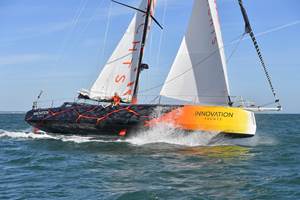NASA highlights sustainable aviation goals for the U.S.
Agency details a plan to reduce aviation carbon emissions by 2030 via a Sustainable Aviation Fuel Grand Challenge (SAFGC), investment in cost-sharing partnerships and demonstration of new technologies, including composite materials.

NASA will demonstrate high-risk, high-reward technology advancements critical for U.S. aerospace manufacturers to bring to market innovative, cost-effective, and sustainable products and services demanded by airlines and customers. Vehicle image created by Scott Anders, Rich Wahls and Lillian Gipson; forest imagery franckreporter, E+, Getty Images
NASA Administrator Bill Nelson joined federal government and industry leaders on Sept. 9 at a White House event highlighting sustainable aviation and the administration’s focus on medium- and long-term goals to combat climate change. NASA also announced its partnership with the FAA and industry partners which will demonstrating new technology, from high-power, hybrid-electric propulsion systems, to advanced composite materials.
The event highlighted a plan to reduce aviation carbon emissions through production of more than three billion gallons of sustainable fuel by 2030. Officials from the Departments of Transportation, Energy and Agriculture announced a Sustainable Aviation Fuel Grand Challenge (SAFGC) to meet this goal, in partnership with industry and other federal agencies. SAFGC aims to reduce costs, enhance the sustainability of aviation, as well as expand the production and use of sustainable aviation fuel to meet 100% of U.S. demand by 2050.
During the event, Nelson delivered remarks underscoring NASA’s origins as an aeronautics research organization and history of improving aviation efficiency and safety. NASA innovations have made aircraft quieter and more fuel efficient while reducing their harmful emissions, he said, making aviation more sustainable environmentally and economically.
“Our aeronautics researchers are developing and testing new green technologies for next-generation aircraft, new automation tools for greener and safer airspace operations and sustainable energy options for aircraft propulsion,” Nelson said.
Further, NASA is investing in cost-sharing partnerships with U.S. companies to research and demonstrate high-risk, high-reward technology for next-generation, single-aisle aircraft that are at least 25% more fuel efficient. These aircraft could see service by the early 2030s. Single-aisle aircraft generate the largest share of aviation carbon emissions of all aircraft class sizes.
“We’re working to keep U.S. companies economically competitive by helping them bring to market the next generation of environmentally sustainable commercial transport aircraft,” said Bob Pearce, NASA’s associate administrator for aeronautics. “The fiercely competitive single-aisle market is an important path to economic recovery for aircraft manufacturers and airlines after COVID-19, and foreign governments are investing heavily in these technologies.”
Under its recently launched Sustainable Flight National Partnership, NASA will collaborate with the Federal Aviation Administration (FAA) and industry partners to accelerate the maturation of aircraft and engine technologies to enable a significant reduction in fuel consumption and CO2 emissions. The partnership’s efforts include demonstrating new technology, such as the first-ever high-power, hybrid-electric propulsion systems for large transport aircraft, long and slender ultra-high efficiency wings and advanced composite materials. NASA will also demonstrate advanced engine technologies based on its breakthrough innovations.
In collaboration with the Department of Energy (DOE), NASA will develop battery technologies that can provide the power required for electric aircraft with vertical takeoff and landing capability, as well as for short-range consumer aircraft. In the long term, these battery technologies could potentially achieve the energy density needed for longer-range electric aircraft as well.
A memorandum of understanding signed at the White House event calls for the development of a government-wide strategic plan to meet these goals. The SAFGC Roadmap will take a multi-generational approach, setting U.S. milestones at 2030, 2040 and 2050.
NASA says it will contribute to the nation’s commitment to sustainable aviation embodied in the SAFGC. Building on its ground and flight campaigns of the past decade, NASA researchers will continue sampling and characterizing the makeup of sustainable aviation fuel emissions to verify performance, and to ensure compatibility of sustainable aviation fuels with existing and future aircraft.
Related Content
JEC World 2024 highlights: Glass fiber recycling, biocomposites and more
CW technical editor Hannah Mason discusses trends seen at this year’s JEC World trade show, including sustainability-focused technologies and commitments, the Paris Olympics amongst other topics.
Read MoreAll-recycled, needle-punched nonwoven CFRP slashes carbon footprint of Formula 2 seat
Dallara and Tenowo collaborate to produce a race-ready Formula 2 seat using recycled carbon fiber, reducing CO2 emissions by 97.5% compared to virgin materials.
Read MoreTrends fueling the composites recycling movement
Various recycling methods are being considered for composites, from novel dismantling and processing, to building capacity and demonstrating secondary use applications.
Read MoreEuropean boatbuilders lead quest to build recyclable composite boats
Marine industry constituents are looking to take composite use one step further with the production of tough and recyclable recreational boats. Some are using new infusible thermoplastic resins.
Read MoreRead Next
Ultrasonic welding for in-space manufacturing of CFRTP
Agile Ultrasonics and NASA trial robotic-compatible carbon fiber-reinforced thermoplastic ultrasonic welding technology for space structures.
Read MoreScaling up, optimizing the flax fiber composite camper
Greenlander’s Sherpa RV cab, which is largely constructed from flax fiber/bio-epoxy sandwich panels, nears commercial production readiness and next-generation scale-up.
Read MoreNext-gen fan blades: Hybrid twin RTM, printed sensors, laser shock disassembly
MORPHO project demonstrates blade with 20% faster RTM cure cycle, uses AI-based monitoring for improved maintenance/life cycle management and proves laser shock disassembly for recycling.
Read More


























